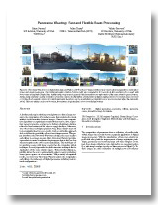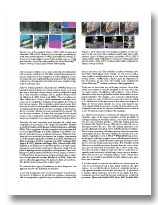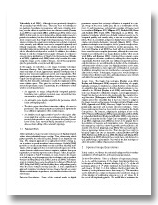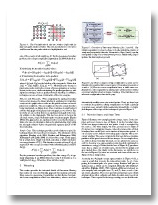Panorama Weaving: Fast and Flexible Seam Processing
 PanoramaWeaving on a challenging data-set (Nation, 12848 x 3821, 9 images) with moving objects during acquisition, registration
issues and varying exposure. Our initial automatic solution (bottom, left) was computed in 4.6 seconds at full resolution for a result with
lower seam energy than Graph Cuts. Additionally, we present a system for the interactive user exploration of the seam solution space (bottom,
right), easily enabling: (a) the resolution of moving objects, (b) the hiding of registration artifacts (split pole) in low contrast areas (scooter)
or (c) the fix of semantic notions for which automatic decisions can be unsatisfactory (stoplight colors are inconsistent after the automatic
solve). The user editing session took only a few minutes. (top) the final, color-corrected panorama.
PanoramaWeaving on a challenging data-set (Nation, 12848 x 3821, 9 images) with moving objects during acquisition, registration
issues and varying exposure. Our initial automatic solution (bottom, left) was computed in 4.6 seconds at full resolution for a result with
lower seam energy than Graph Cuts. Additionally, we present a system for the interactive user exploration of the seam solution space (bottom,
right), easily enabling: (a) the resolution of moving objects, (b) the hiding of registration artifacts (split pole) in low contrast areas (scooter)
or (c) the fix of semantic notions for which automatic decisions can be unsatisfactory (stoplight colors are inconsistent after the automatic
solve). The user editing session took only a few minutes. (top) the final, color-corrected panorama.
A fundamental step in stitching several pictures to form a larger mosaic
is the computation of boundary seams that minimize the visual
artifacts in the transition between images. Current seam computation
algorithms use optimization methods that may be slow, sequential,
memory intensive, and prone to finding suboptimal solutions
related to local minima of the chosen energy function. Moreover,
even when these techniques perform well, their solution may not
be perceptually ideal (or even good). Such an inflexible approach
does not allow the possibility of user-based improvement. This paper
introduces the Panorama Weaving technique for seam creation
and editing in an image mosaic. First, Panorama Weaving provides
a procedure to create boundaries for panoramas that is fast, has low
memory requirements and is easy to parallelize. This technique often
produces seams with lower energy than the competing global
technique. Second, it provides the first interactive technique for the
exploration of the seam solution space. This powerful editing capability
allows the user to automatically extract energy minimizing
seams given a sparse set of constraints. With a variety of empirical
results, we show how Panorama Weaving allows the computation
and editing of a wide range of digital panoramas including unstructured
configurations.
@article{Summa:2012:PWF:2185520.2335434,
author = {Summa, Brian and Tierny, Julien and Pascucci, Valerio},
title = {Panorama weaving: fast and flexible seam processing},
journal = {ACM Trans. Graph.},
issue_date = {July 2012},
volume = {31},
number = {4},
month = jul,
year = {2012},
issn = {0730-0301},
pages = {83:1--83:11},
articleno = {83},
numpages = {11},
url = {http://doi.acm.org/http://doi.acm.org/10.1145/2185520.2185579},
doi = {http://doi.acm.org/10.1145/2185520.2185579},
acmid = {2335434},
publisher = {ACM},
address = {New York, NY, USA},
}



